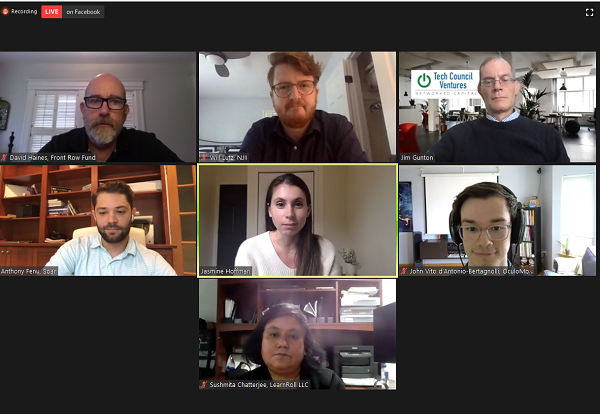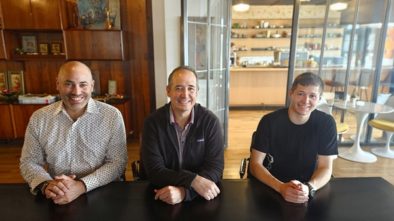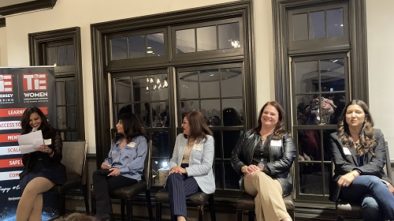August Showdown Highlights Two AR/VR Startups from New Jersey
Three startup founders in the augmented reality (AR) and virtual reality (VR) market space, two of them from New Jersey, pitched to a panel of investors at a Startup Showdown last month.
The Startup Showdowns are sponsored by TechUnited:NJ and Tech Council Ventures and are moderated by Jasmine Hoffman, head of experience at TechUnited:NJ.
Presenting were:
- OculoMotor Technologies (Newark), a company that enables optometrists to diagnose and treat common vision disorders with the latest in consumer-available VR technologies;
- Learnroll Immerse (Belle Mead), an educational technology company that is targeting students who need to learn and medical and life-science subjects, using a digital platform and AR/VR solutions; and
- Soar (Philadelphia), a vertically integrated content creation/distribution platform for the streaming of volumetric video, including AR and VR feeds, in real time.
The investor panel for this event included Jim Gunton, founder and managing partner of Tech Council Ventures (Summit); Will Lutz, general manager for entrepreneurship at the New Jersey Innovation Institute (Newark); and David Haines, partner at Front Row Fund (Newtown, Pa.). A complete video of the event can be found here.
VR Software to Cure Convergence Insufficiency
First to present was OculoMotor Technologies’ CEO, John Vito d’Antonio-Bertagnolli, who discussed an eye problem that affects one out of 20 people: convergence insufficiency. This occurs when sufferers go from looking at something far away to looking at something close up. Symptoms include blurry and double vision, headaches, dizziness and nausea when one is performing those everyday activities that are closest to the face, such as reading a book, looking at a computer or looking at a phone, he said.
The current cure is a series of exercises performed under the supervision of an optometrist, to get the eye muscles working well again. “Unfortunately, they’re indescribably boring,” d’Antonio-Bertagnolli said. The most commonly prescribed exercise is the pencil pushup. “You hold a pencil far away from your face and you bring it close to your face until it doubles, you do that for three to five minutes, three to five times a day for eight to 12 weeks.” Kids with attention deficit disorder” and others just get too impatient to complete it, he said.
He noted that his company has gamified the therapy to make it more engaging for the patient. “The very thing that makes VR work, that makes it so volumetric (3D) and immersive for the rest of us, is actually really hard for patients with convergence insufficiency, so we finely tune the mechanics of the headset and the software that we’re using to present really easy visual stimuli that elicit these eye-crossing movements.”
The company has done some analysis on this, and developed eye-tracking hardware inside the headsets that can classify movements. “What we’re able to do with this is ride the bleeding edge of a patient’s ability level. If you’re doing really well, we make the therapy harder. If you’re not doing so well, we make the therapy a little bit easier. And by riding the bleeding edge of their ability level, we actually show really phenomenal efficacy using this software.”
The NJIT startup already received more than $500,000 in funding from the New Jersey Health Foundation’s venture arm, as well as a $225,000 grant from the federal government’s Small Business Innovation Research (SBIR) program.
Will Lutz, who is also a codirector of NJIT’s VentureLink, gave d’Antonio-Bertagnolli some feedback about his presentation. He said that he wanted to be hooked in by the story, but he thought the pitch was a bit academic. “And I’d like to get that emotional connection,” Lutz told him. He also wanted to hear more about the company’s go-to-market plans, how it will make money and how it would get the product in front of the right people.
Immersive VR for Learning Medical and Life-Science Subjects
Next to present was Sushmita Chatterjee, founder and CEO of Learnroll Immerse, which is using immersive VR to help Gen Z and millennial students learn medical and life-science subjects better. The company has created both content and software to support learning in these areas. It is targeting a very niche market at first, and expects adoption to proceed as VR adoption continues. The AR/VR opportunity amounts to $5.2 billion, as it straddles both the edtech and healthtech markets, she said. Learnroll is partnering with Oculus (Menlo Park, Calif.), a video-game company owned by Facebook, in this undertaking, Chatterjee noted, and it has piloted the product and some content with both post-high school students and doctors.
Some of the panelists said that the presentation wasn’t clear enough and that they didn’t have a good idea of what the company actually did. Gunton noted that the product has a “wow factor” because people learn better when they see images and videos. Chatterjee responded to a question about how she differentiated Learnroll from competitors by noting that the startup is working on a web version of the product, so that people can use VR with a web browser like Mozilla through Oculus’ WebVR product.
Soar, for Streaming 3D Data
Presenting last was Anthony Fenu, cofounder and CEO of Soar. He told the group that Soar is a vertically integrated content creation and distribution platform for volumetric video. Volumetric video is video that captures 3D content from video games and other VR sources. Historically, with volumetric data, the cost of capturing content has been very high, as the process requires large studios with controlled environments, Fenu said. Right now, companies like Microsoft and Intel are offering capture solutions that cost anywhere from $25,000 to $75,000 per day of capture, he noted. And the biggest issue with captured content coming out of those studios is that the file sizes are so large, streaming is practically impossible.
“[What] we set out to do from the jump was to reduce this barrier to entry for people to create high-quality volumetric content, and then also allow them to distribute it.” To do that, the company built a series of tools that included compression, filtering and AI and machine-learning components to fill in the gaps, Fenu said. “That allows us to stream high-quality, real-time content over” a lower-quality connection, he said.
Haines asked if Soar has done a scalability study. Fenu responded that his company hadn’t done any formal studies, but what it had done on the networking side would allow Soar to handle big volumes of visual data. Haines also asked Fenu about the company’s customers and road map. Fenu said that, for smaller-scale capture, they can enable anyone to use the system now. Initial customers include ad agencies, talent agencies and a large music group. The company has done beta tests with this group of customers, Fenu added. He also said that Soar can best any competition on price because of the compression techniques used in the product.
At the end of the event, attendees voted on who gave the best pitch. The winner was d’Antonio-Bertagnolli, of OculoMotor Technologies.




